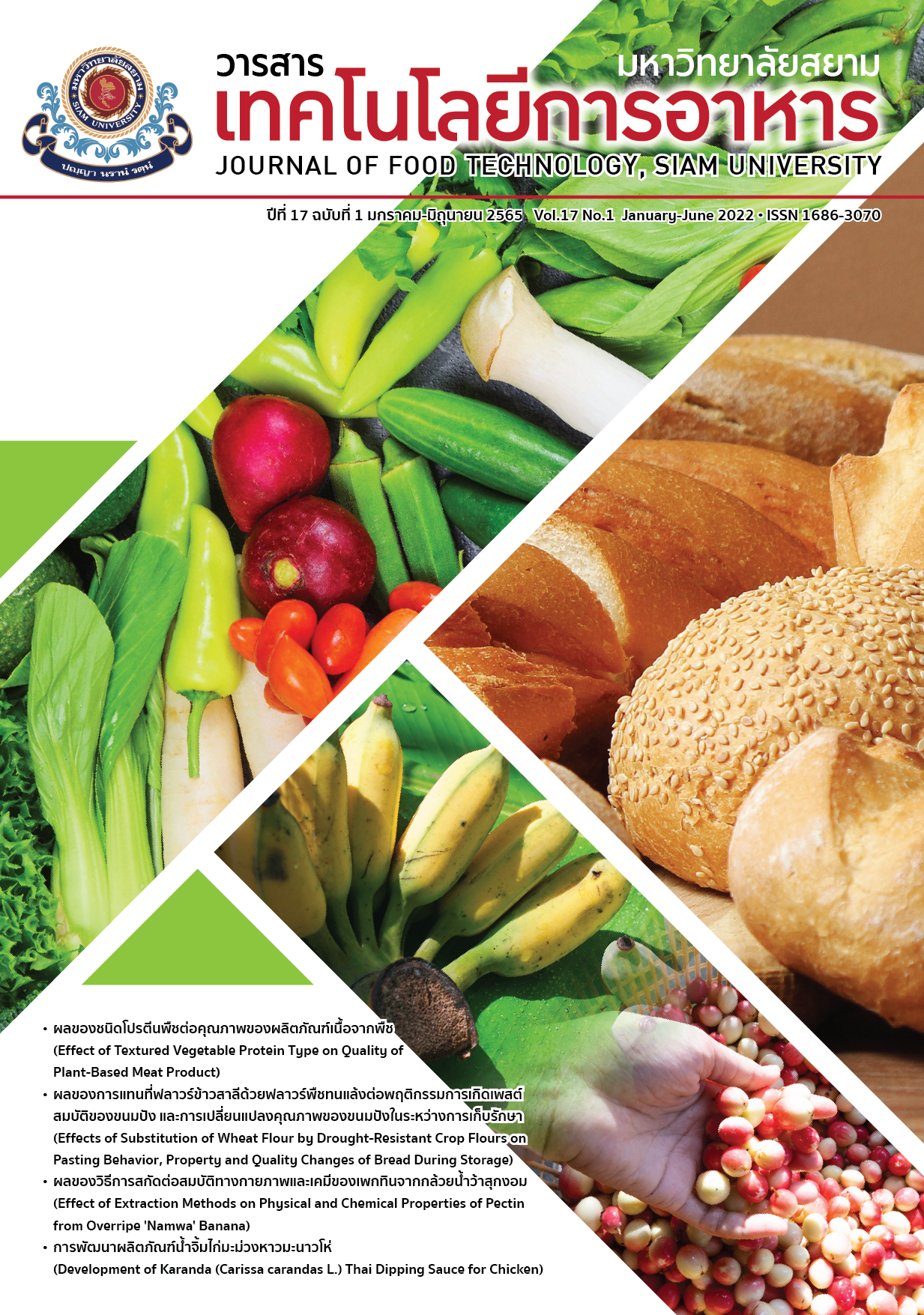การพัฒนาผลิตภัณฑ์น้ำจิ้มไก่มะม่วงหาวมะนาวโห่
Main Article Content
บทคัดย่อ
งานวิจัยนี้มีวัตถุประสงค์เพื่อคัดเลือกน้ำจิ้มไก่สูตรพื้นฐานและพัฒนาน้ำจิ้มไก่สูตรมะม่วงหาวมะนาวโห่ทดแทนน้ำส้มสายชูที่ระดับร้อยละ 0, 25, 50, 75 และ 100 ตามลำดับ พบว่าผู้ทดสอบชิมให้การยอมรับน้ำจิ้มไก่สูตรทดแทนมะม่วงหาวมะนาวโห่ที่ระดับร้อยละ 100 โดยเฉพาะลักษณะด้านกลิ่นและรสชาติ (p<0.05) การใช้น้ำมะม่วงหาวมะนาวโห่ทดแทนน้ำส้มสายชูส่งผลต่อคุณลักษณะและคุณภาพของน้ำจิ้มไก่ที่ได้ ด้านคุณภาพทางกายภาพ พบว่าน้ำจิ้มไก่สูตรทดแทนมะม่วงหาวมะนาวโห่ ร้อยละ 100 มีสีเข้มขึ้นแต่ไม่มีนัยสำคัญ เกิดจากสีของมะม่วงหาวมะนาวโห่ และพบว่ามีค่าความหนืดสูงกว่าน้ำจิ้มไก่สูตรพื้นฐานอย่างมีนัยสำคัญ (p<0.05) คุณภาพทางเคมี พบว่า น้ำจิ้มไก่สูตรทดแทนมะม่วงหาวมะนาวโห่มีปริมาณของแข็งที่ละลายได้ทั้งหมดเท่ากับ 64.50±0.01 °Brix มีค่าความเป็นกรด-ด่าง เท่ากับ 2.99±0.03 มีปริมาณกรด เท่ากับ ร้อยละ 1.82±0.02 ปริมาณสารประกอบฟีนอลิกทั้งหมด เท่ากับ 0.75±0.00 mg GAE/g และมีฤทธิ์ต้านอนุมูลอิสระ DPPH เท่ากับ 6.25±0.00 µmole Trolox/g นอกจากนี้การใช้น้ำมะม่วงหาวมะนาวโห่ทดแทนน้ำส้มสายชูในน้ำจิ้มไก่ พบว่าทำให้มีปริมาณคาร์โบไฮเดรตและค่าพลังงานสูงกว่าน้ำจิ้มไก่สูตรพื้นฐาน น้ำจิ้มไก่สูตรมะม่วงหาวมะนาวโห่ที่ผลิตได้มีความปลอดภัยจากเชื้อก่อโรคและจุลินทรีย์ที่ทำให้เกิดการเน่าเสียซึ่งเป็นไปตามมาตรฐานของน้ำจิ้มไก่
Article Details

This work is licensed under a Creative Commons Attribution-NonCommercial-NoDerivatives 4.0 International License.
บทความทุกบทความในวารสารเทคโนโลยีการอาหาร ทั้งในรูปแบบสิ่งพิมพ์ และในระบบออนไลน์ ถือเป็นลิขสิทธิ์ของมหาวิทยาลัยสยาม และได้รับการคุ้มครองตามกฎหมาย
References
Svangnabha. (2019). Daily news variety column: A variety of flavors ‘dipping sauces’ the charm of Thai foods set. [Online] Available from http://bit.ly/38WIqb2 [Accessed December 15, 2021]. (In Thai).
Thai Industrial Standards Institute. (2013). Thai community product standard: Dipping sauce for chicken, tcps. 514-2556.
Maheshwari, R., Sharma, A. and Verma, D. (2012). Phyto-therapeutic significance of karaunda. Bulletin of Environment Pharmacology and Life Sciences. 1(12): 34-36.
Watrabut, S. (2010). Chemical constituents of karanda fruit (Carissa caranda Linn.). Unpublished bachelor’s thesis, Rambhai Barni Rajabhat University, Chanthaburi, Thailand. (In Thai).
Chaovanalikit, A. (2011). Extraction and analysis of anthocyanin. Journal of Science and Technology, Srinakharinwirot University. 3(6): 26-36. (In Thai).
Puttame, K., Sawasdikarn, J. and Chitphutthanakul, S. (2016). Effect of karanda fruit (Carissa caranda Linn.) and water ratio on physical, chemical properties and sensory quality of karanda. Rajabhat Rambhai Barni Research Journal. 10(3): 114-118. (In Thai).
Pewlong, W., Sajjabut, S., Singphet, S. and Eamsiri, J. (2013). Influence of fruit ripening stages on the bioactive compounds of Carissa carandas. Agricultural Science Journal. 44(2)(Suppl.): 337-340. (In Thai).
Maeban. (2012). Dipping sauces, salad dressing seasoning. Maeban, Bangkok. (In Thai).
Sangdad. (2008). 121 Delicious dipping sauces. (3rd ed.). Sangdad Publishing,Bangkok. (In Thai).
Nicolas, L., Marquilly, C. and O’Mahony, M. (2010). The 9-point hedonic scale: Are words and numbers compatible?. Food Quality and Preference. 21(8): 1008-1015.
Rittilert, P. (2017). Handbook for dried osmotic dehydrated fruits processing: Karanda Fruit (Carissa carandas L.). (1st ed.). Pathum Thani: Faculty of Agricultural Technology, Valaya Alongkorn Rajabhat University under The Royal Patronage. (In Thai).
AOAC. (2006). Official methods of analysis. (18th ed.). Association of Official Analytical Chemists. Gaithersburgs, MD.
AOAC. (2016). Official methods of analysis. Association of Official Analytical Chemists.
Washington D.C.
AOAC. (2019). Official methods of analysis of AOAC international. (21st ed.). Gaithersburg, Maryland.
AOAC. (2012). Official method of analysis. (19th ed.). Association of Official Analytical Chemists. Washington D.C.
Maizura, M., Aminah, A. and Wan Aida, W.M. (2011). Total phenolic content and antioxidant activity of kesum (Polygonum minus), ginger (Zingiber officinale) and turmeric (Curcuma longa) extract. International Food Research Journal. 18: 529-534.
Zigoneanu, I.G., Williams, L., Xu, Z. and Sablior, C.M. (2007). Determination of antioxidant components in rice bran oil extraction by microwave-assisted method.Bioresource Technology. 99: 4910-4918.
BAM. (2001). Bacteriological Analytical Manual Online. Food and Drug Administration: Silver Spring, MD.
ISO. (2017). ISO 6579-1: 2017. Microbiology of the food chain - Horizontal method for the detection, enumeration and serotyping of Salmonella- Part 1: Detection of Salmonella spp. Geneva, Switzerland.
BAM. (2016). Bacteriological Analytical Manual Online. Food and Drug Administration: Silver Spring, MD.
Williams, L.J. and Abdi, H. (2010). Fisher’s Least Significant Difference (LSD) Test. In N. Salkind. (Ed.), Encyclopedia of Research Design. (pp.154). Sage, Thousand Oaks.
Rittilert, P. and Warin, K. (2020). Development of karanda (Carissa carandas L.) gummy jelly product. Thai Journal of Science and Technology. 9(2): 342-354. (In Thai).
Tatongjai, K. and Laokuldilok, T. (2018). Effects of purple rice bran addition on the physiochemical-sensorial properties and storage stability of Chinese sausage. Journal of Food Technology, Siam University. 13(1): 44-57. (In Thai).
Suwannalers, P. (2012). Development of butterfly pea kalamae product. Chiang Mai Rajabhat University. [Online] Available from http://cmruir.cmru.ac.th/handle/ 123456789/156 [Accessed January 15, 2021]. (In Thai).
Lisnund, S. and Srihaphong, S. (2015). Ultraviolet spectrophotometric for determination of ascorbic acid in pharmaceutical tablets and carambola fruit by sodium thiosulfate solution. Rajamangala University of Technology Tawan-ok Research Journal. 8(2): 92-100. (In Thai).
Kumar, S., Gupta, P. and Gupta K.L.V. (2013). A critical review on karamarda (Carissa carandas Linn.). International Journal of Pharmaceutical and Biological Science Archive. 4(4): 637-642.

